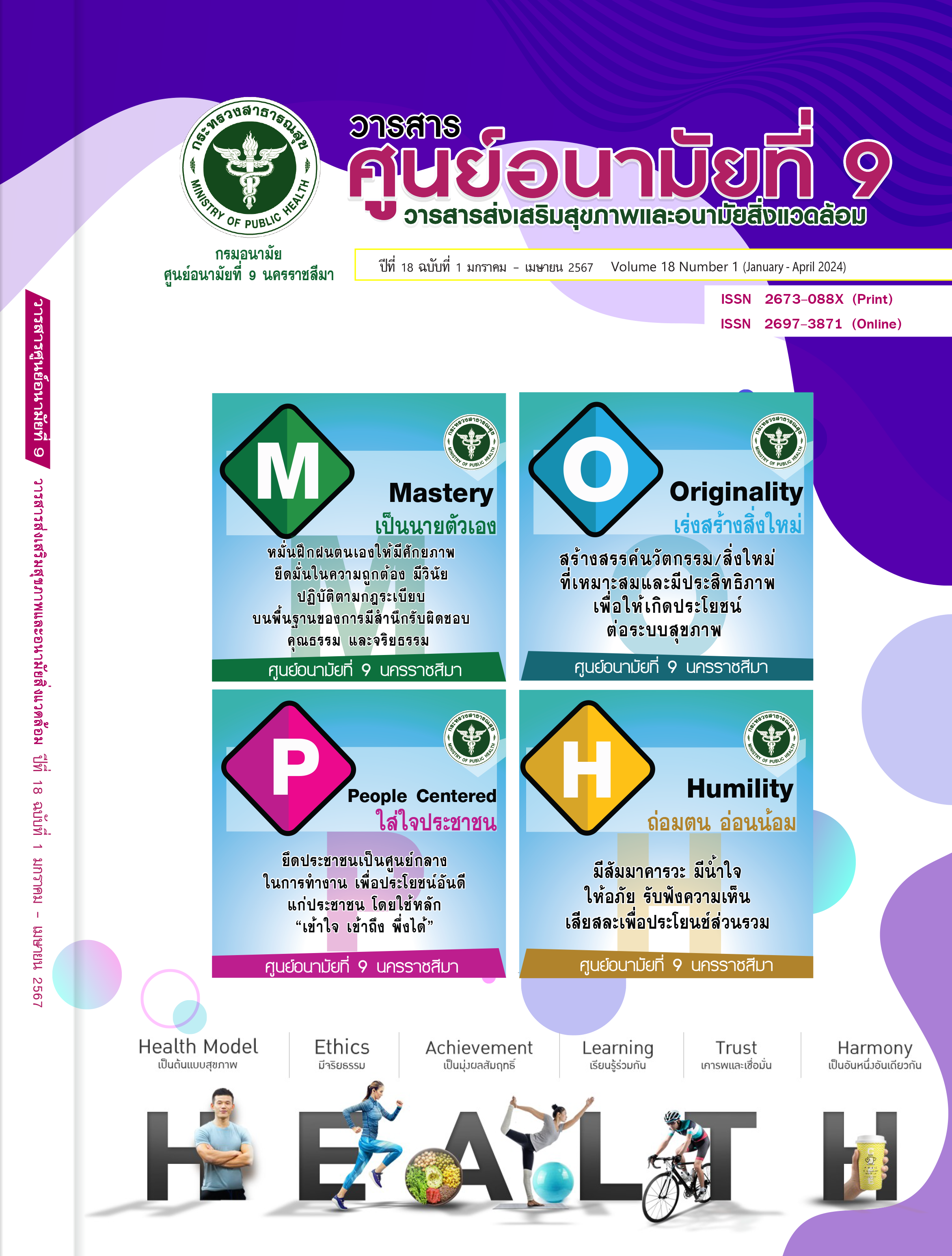ปัจจัยเสี่ยงการเกิดปอดติดเชื้อหลังผ่าตัด ในผู้ป่วยสูงอายุกระดูกข้อสะโพกหัก โรงพยาบาลภูเขียวเฉลิมพระเกียรติ จังหวัดชัยภูมิ
คำสำคัญ:
ปอดติดเชื้อ, กระดูกหักจากภัยอันตรายไม่รุนแรง, ผู้สูงอายุ, ปัจจัยเสี่ยงบทคัดย่อ
ผู้สูงอายุกระดูกข้อสะโพกหักพบปอดติดเชื้อได้ ร้อยละ 5.1-14 อัตราการเสียชีวิตใน 30 วันแรกหลังจากการผ่าตัด ร้อยละ 27-43 การนอนโรงพยาบาลซ้ำเพิ่ม 8 เท่าเมื่อเทียบกับผู้ป่วยที่ไม่มีปอดติดเชื้อ รูปแบบการศึกษาเชิงพรรณนาย้อนหลังศึกษาข้อมูลเวชระเบียนผู้ป่วยใน ผู้ป่วยกระดูกข้อสะโพกหักอายุมากกว่าหรือเท่ากับ 50 ปีจากภัยอันตรายไม่รุนแรงจำนวน 227 ราย ผู้ป่วยปอดติดเชื้อจำนวน 18 ราย คิดเป็นร้อยละ 7.93 และผู้ป่วยไม่มีปอดติดเชื้อจำนวน 209 รายคิดเป็นร้อยละ 92.07 ปัจจัยเสี่ยงที่ศึกษา ได้แก่ อายุ เพศ ดัชนีมวลกาย (BMI) การสูบบุหรี่ จำนวนเวลาและระยะเวลาตั้งแต่แรกรับนอนโรงพยาบาลถึงเวลาผ่าตัด ระดับ Serum albumin ระดับน้ำตาลในกระแสเลือด ASA Classification การใช้ยาออกฤทธิ์ต่อจิตและประสาท โรคประจำตัว จำนวนวันที่นอนโรงพยาบาล และโปรแกรมกายภาพบำบัด โดยกำหนดระดับนัยสำคัญทางสถิติที่ p-valve=0.05 ผลการศึกษา พบว่าปัจจัยเสี่ยงปอดติดเชื้อได้แก่โรคปอดอุดกั้นเรื้อรัง (p-valve=0.035) และ ASA classification (p-valve=0.028) ปอดติดเชื้อพบได้น้อยในกลุ่มผู้ป่วยได้รับการกายภาพบำบัดปอดตั้งแต่วันแรกรับนอนโรงพยาบาล (p-valve=0.005) การเกิดปอดติดเชื้อทำให้ระยะเวลานอนโรงพยาบาลเพิ่มมากขึ้น (p-valve=0.003) สรุปว่า การกายภาพบำบัดปอดตั้งแต่วันแรกรับนอนโรงพยาบาลป้องกันโรคปอดติดเชื้อ ผู้ป่วยที่มีโรคประจำตัวโรคถุงลมโป่งพอง ASA Classification > 3 และผู้ป่วยที่เข้ารับการรักษานอนโรงพยาบาลนานเป็นกลุ่มเสี่ยงสูงต่อการเกิดปอดติดเชื้อ การดูแลรักษาควรต้องเฝ้าระวังปอดติดเชื้อ ผู้ป่วยทุกรายควรได้รับการกายภาพบำบัดปอดตั้งแต่วันแรกรับนอนโรงพยาบาล
เอกสารอ้างอิง
Dargent-Molina P, Favier F, Grandjean H, Baudoin C, Schott AM, Hausherr E, et al. Fall-related factors and risk of hip fracture: the EPIDOS prospective study. Lancet. 1996 Jul 20;348(9021):145-9. doi: 10.1016/s0140-6736(96)01440-7.
Thorell K, Ranstad K, Midlöv P, Borgquist L, Halling A. Is use of fall risk-increasing drugs in an elderly population associated with an increased risk of hip fracture, after adjustment for multimorbidity level: a cohort study. BMC Geriatr. 2014 Dec 4;14:131. doi: 10.1186/1471-2318-14-131.
Fuller GF. Falls in the elderly. Am Fam Physician. 2000 Apr 1;61(7):2159-68, 2173-4. PMID: 10779256.
Tay E. Hip fractures in the elderly: operative versus nonoperative management. Singapore Med J. 2016 Apr;57(4):178-81. doi: 10.11622/smedj.2016071.
Parker MJ. Current concepts in the treatment of hip fracture. Z Gerontol Geriatr. 2001 Feb;34(1):74-7. doi: 10.1007/s003910170096.
Goh EL, Lerner RG, Achten J, Parsons N, Griffin XL, Costa PML. Complications following hip fracture: Results from the World Hip Trauma Evaluation cohort study. Injury. 2020 Jun;51(6):1331-6. doi: 10.1016/j.injury.2020.03.031.
Bohl DD, Sershon RA, Saltzman BM, Darrith B, Della Valle CJ. Incidence, Risk Factors, and Clinical Implications of Pneumonia After Surgery for Geriatric Hip Fracture. J Arthroplasty. 2018 May;33(5):1552-6.e1. doi: 10.1016/j.arth.2017.11.068.
Pratt N, Roughead EE, Ramsay E, Salter A, Ryan P. Risk of hospitalization for hip fracture and pneumonia associated with antipsychotic prescribing in the elderly: a self-controlled case-series analysis in an Australian health care claims database. Drug Saf. 2011 Jul 1;34(7):567-75. doi: 10.2165/11588470-000000000-00000.
Wang X, Dai L, Zhang Y, Lv Y. Gender and Low Albumin and Oxygen Levels are Risk Factors for Perioperative Pneumonia in Geriatric Hip Fracture Patients. Clin Interv Aging. 2020 Mar 19;15:419-24. doi: 10.2147/CIA.S241592.
Tian Y, Zhu Y, Zhang K, Tian M, Qin S, Li X, et al. Incidence and risk factors for postoperative pneumonia following surgically treated hip fracture in geriatric patients: a retrospective cohort study. J Orthop Surg Res. 2022 Mar 24;17(1):179. doi: 10.1186/s13018-022-03071-y.
Meyer AC, Eklund H, Hedström M, Modig K. The ASA score predicts infections, cardiovascular complications, and hospital readmissions after hip fracture - A nationwide cohort study. Osteoporos Int. 2021 Nov;32(11):2185-92. doi: 10.1007/s00198-021-05956-w.
Han SB, Kim SB, Shin KH. Risk factors for postoperative pneumonia in patients undergoing hip fracture surgery: a systematic review and meta-analysis. BMC Musculoskelet Disord. 2022 Jun 8;23(1):553. doi: 10.1186/s12891-022-05497-1.
Regan EA, Radcliff TA, Henderson WG, Cowper Ripley DC, Maciejewski ML, Vogel WB, et al. Improving hip fractures outcomes for COPD patients. COPD. 2013 Feb;10(1):11-9. doi: 10.3109/15412555.2012.723072.
Ståhl A, Westerdahl E. Postoperative Physical Therapy to Prevent Hospital-acquired Pneumonia in Patients Over 80 Years Undergoing Hip Fracture Surgery-A Quasi-experimental Study. Clin Interv Aging. 2020 Oct 1;15:1821-9. doi: 10.2147/CIA.S257127.
Chang SC, Lai JI, Lu MC, Lin KH, Wang WS, Lo SS, et al. Reduction in the incidence of pneumonia in elderly patients after hip fracture surgery: An inpatient pulmonary rehabilitation program. Medicine (Baltimore). 2018 Aug;97(33):e11845. doi: 10.1097/MD.0000000000011845.
Salarbaks AM, Lindeboom R, Nijmeijer W. Pneumonia in hospitalized elderly hip fracture patients: the effects on length of hospital-stay, in-hospital and thirty-day mortality and a search for potential predictors. Injury. 2020 Aug;51(8):1846-50. doi: 10.1016/j.injury.2020.05.017.
Nikkel LE, Kates SL, Schreck M, Maceroli M, Mahmood B, Elfar JC. Length of hospital stay after hip fracture and risk of early mortality after discharge in New York state: retrospective cohort study. BMJ. 2015 Dec 10;351:h6246. doi: 10.1136/bmj.h6246.
ดาวน์โหลด
เผยแพร่แล้ว
รูปแบบการอ้างอิง
ฉบับ
ประเภทบทความ
สัญญาอนุญาต
ลิขสิทธิ์ (c) 2023 วารสารศูนย์อนามัยที่ 9 : วารสารส่งเสริมสุขภาพและอนามัยสิ่งแวดล้อม

อนุญาตภายใต้เงื่อนไข Creative Commons Attribution-NonCommercial-NoDerivatives 4.0 International License.
บทความหรือข้อคิดเห็นใด ๆ ที่ประกฎในวารสารศูนย์อนามัยที่ 9 เป็นความคิดเห็นของผู้เขียน บรรณาธิการ คณะผู้จัดทำ และศูนย์อนามัยที่ 9 นครราชสีมา (เจ้าของ) ไม่จำเป็นต้องเห็นด้วย ผู้เขียนต้องรับผิดชอบต่อบทความของตนเอง
ผลการพิจารณาของกองบรรณาธิการและผู้ทรงคุณวุฒิถือเป็นที่สิ้นสุด คณะบรรณาธิการวารสารฯ ขอสงวนสิทธิ์ในการตรวจแก้ไขข้อความให้ถูกต้องตามหลักภาษาและมีความเหมาะสม
กองบรรณาธิการวารสารฯ ขอสงวนสิทธิ์มิให้นำเนื้อหาใด ๆ ของบทความ หรือข้อคิดเห็นใด ๆ ของผลการประเมินบทความในวารสารฯ ไปเผยแพร่ก่อนได้รับอนุญาตจากกองบรรณาธิการ อย่างเป็นลายลักษณ์อักษร และผลงานที่ได้รับการตีพิมพ์ถือเป็นลิขสิทธิ์ของวารสารศูนย์อนามัยที่ 9


